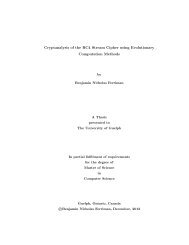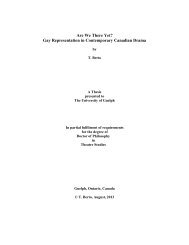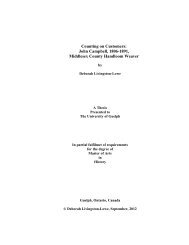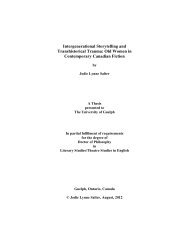THESIS - ROC CH ... - FINAL - resubmission.pdf - University of Guelph
THESIS - ROC CH ... - FINAL - resubmission.pdf - University of Guelph
THESIS - ROC CH ... - FINAL - resubmission.pdf - University of Guelph
Create successful ePaper yourself
Turn your PDF publications into a flip-book with our unique Google optimized e-Paper software.
onding between hydroxyl groups and oxygen atoms <strong>of</strong> adjacent molecules (Moon et al. 2011).<br />
In plants, the parallel stacking <strong>of</strong> cellulose chains forms the elementary fibrils <strong>of</strong> the hierarchical<br />
structure. These fibrils, when aggregated in numbers, form larger micr<strong>of</strong>ibrils (5-50 nm in<br />
diameter) with crystalline and amorphous regions (Figure 2.1b). The arrangement <strong>of</strong> these<br />
regions varies between materials and is not yet understood, but it is believed that hydrogen<br />
bonding plays a pivotal role in the formation <strong>of</strong> complex cellulosic network (Moon et al. 2011).<br />
Due to the many hydrogen bonds between cellulose chains, micr<strong>of</strong>ibrils are relatively stable and<br />
have high axial stiffness. These nan<strong>of</strong>ibers tend to have high aspect ratios (µm in length to nm<br />
diameter), and depending on the extraction method and the source material used (wood, ramie,<br />
jute, etc.), aspect ratios will differ. Micr<strong>of</strong>ibrils are ideal reinforcement structures and have been<br />
proven to be difficult to solubilize (Eichhorn et al. 2009). Within the cell wall, these micr<strong>of</strong>ibrils<br />
are embedded in a gel-like matrix composed <strong>of</strong> hemicellulose, lignin and pectin polysaccharides<br />
(Wolf-Dieter 1998).<br />
11

















